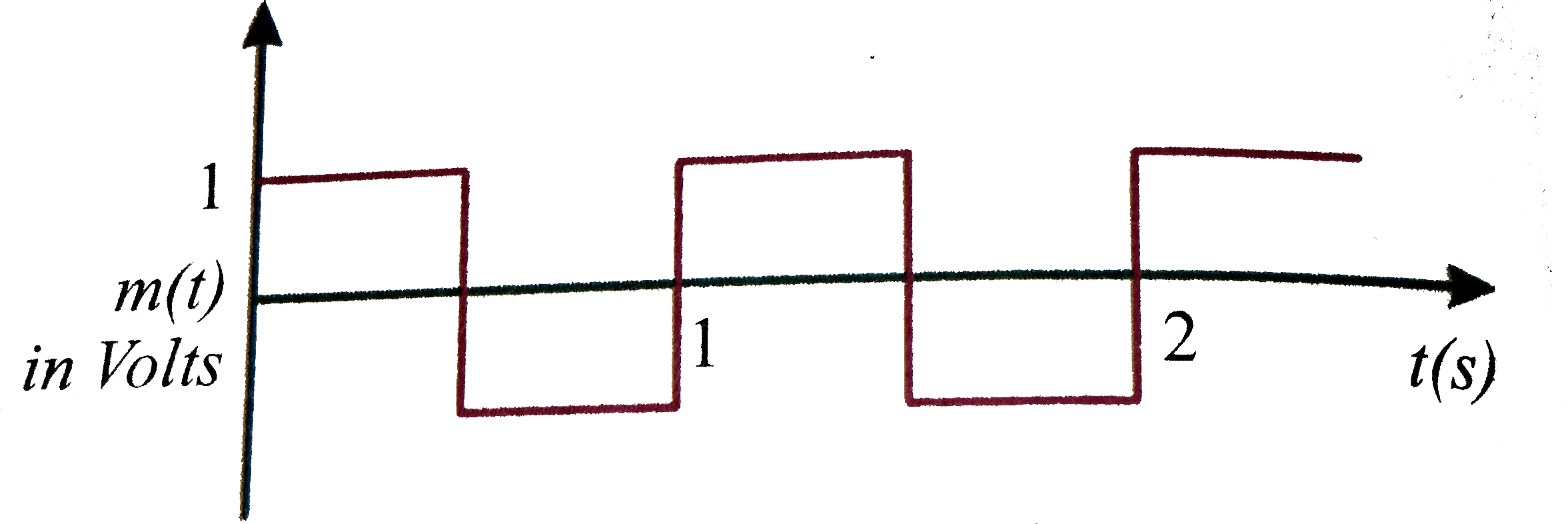An audio signal Vm=5sin6π×103t is to be modulated on a carrier wave given by Vc=15sin2π×105t The frequencies of side bands and band width
103 KHz , 97 KHz , 6 KHz
130 KHz , 70 KHz , 6 KHz
130 KHz , 97 KHz , 3 KHz
103 KHz , 97 KHz , 3 KHz
The correct Answer is:A
To solve the problem, we need to determine the frequencies of the sidebands and the bandwidth of the modulated signal. Let's break it down step by step.
Step 1: Identify the frequencies of the audio signal and the carrier wave
The audio signal is given by:
Vm=5sin(6π×103t)
From this, we can identify the frequency fm of the audio signal:
fm=6π×1032π=3×103 Hz=3 kHz
The carrier wave is given by:
Vc=15sin(2π×105t)
From this, we can identify the frequency fc of the carrier wave:
fc=105 Hz=100 kHz
Step 2: Calculate the frequencies of the sidebands
The frequencies of the sidebands are given by:
- Lower Sideband (LSB):
fLSB=fc−fm
- Upper Sideband (USB):
fUSB=fc+fm
Now, substituting the values:
1. For the Lower Sideband:
fLSB=100 kHz−3 kHz=97 kHz
2. For the Upper Sideband:
fUSB=100 kHz+3 kHz=103 kHz
Step 3: Calculate the bandwidth
The bandwidth BW of the modulated signal is the difference between the frequencies of the upper and lower sidebands:
BW=fUSB−fLSB
Substituting the values we found:
BW=103 kHz−97 kHz=6 kHz
Final Results
- Frequencies of the sidebands:
- Lower Sideband: 97 kHz
- Upper Sideband: 103 kHz
- Bandwidth: 6 kHz
Vm=5sin(6π×103t)
fm=6π×1032π=3×103 Hz=3 kHz
Vc=15sin(2π×105t)
fc=105 Hz=100 kHz
- Lower Sideband (LSB):
fLSB=fc−fm
- Upper Sideband (USB):
fUSB=fc+fm
1. For the Lower Sideband:
fLSB=100 kHz−3 kHz=97 kHz
fUSB=100 kHz+3 kHz=103 kHz
BW=fUSB−fLSB
BW=103 kHz−97 kHz=6 kHz
- Frequencies of the sidebands:
- Lower Sideband: 97 kHz
- Upper Sideband: 103 kHz
- Bandwidth: 6 kHz
Topper's Solved these Questions
- COMMUNICATION SYSTEMS BOOK - AAKASH SERIESCHAPTER - COMMUNICATION SYSTEMS EXERCISE - Exercise - III (Modulation & Power)
9 Videos
- COMMUNICATION SYSTEMS BOOK - AAKASH SERIESCHAPTER - COMMUNICATION SYSTEMS EXERCISE - PROBLEM
15 Videos
- COMMUNICATION SYSTEMS BOOK - AAKASH SERIESCHAPTER - COMMUNICATION SYSTEMS EXERCISE - Exercise - II (Antenna)
7 Videos
- COMMUNICATION SYSTEM BOOK - AAKASH SERIESCHAPTER - COMMUNICATION SYSTEM EXERCISE - LECTURE SHEET (LEVEL - I) (MAIN) (EXERCISE - IV) (Straight Objective & More than one Correct Answer Type Questions)
20 Videos
- CURRENT ELECTRICITYBOOK - AAKASH SERIESCHAPTER - CURRENT ELECTRICITYEXERCISE - PROBLEMS (LEVEL-II)
27 Videos
Similar Questions
An аudio signal given by es=15sin2π(200t) modulates a carrier wave given by es=60sin2π(100,000t). If calculate
Percent modulation
View SolutionAn аudio signal given by es=15sin2π(200,10t) modulates a carrier wave given by es=60sin2π(10,1000t). If calculate
Frequency spectrum of the modulated wave.
View Solution
Knowledge Check
A modulating signal is a square wave as shown in figure.

The carrier wave is given by
c(t)=2sin(8πt)volt.
The modulation index isA0.2B0.3C0.4D0.5
The carrier wave is given by
C(t) = 2sin(8πt)volt.
The modulating signal is a square wave as shown. Find modulation index.
View SolutionThe modulating wave is given by Vm=6sinωt and the carrier wave is given by Vc=12sinωt. The percentage of modulation is
View SolutionThe audio signal voltage is given by Vm=2sin12π×103t. The band width and LSB if carrier wave has a frequency 3.14×106rad/s.
View SolutionAn sudio signal Vm=15ω1t is modulated on a CW of Vc=60sinω2t. The percentage modulation is
View SolutionIn an amplitude modulator circuit, the carrier wave is given by,
C(t)=4sin(20000πt) while modulating signal is given by, m(t)=2sin(2000πt). The values of modulation index and lower side band frequency are :
View SolutionFrom a wave equation
y=0.5sin(2π3.2)(64t−x).
the frequency of the wave is
View SolutionA modulating signal is a square wave as shown in figure.

The carrier wave is given by
c(t)=2sin(8πt)volt.
The modulation index is
View Solution
